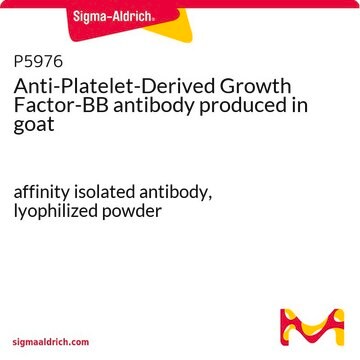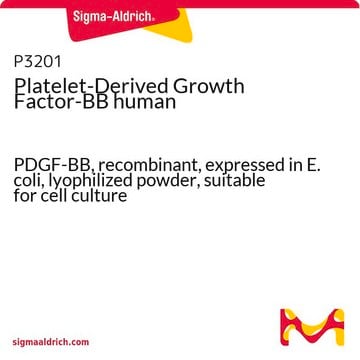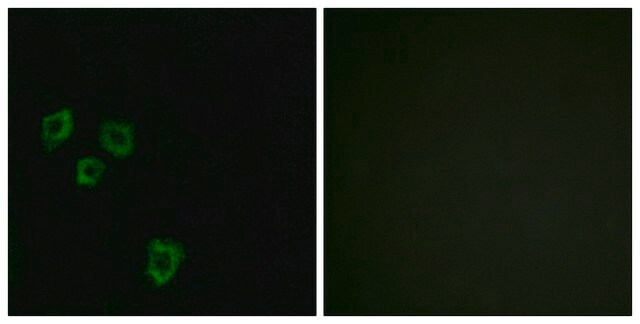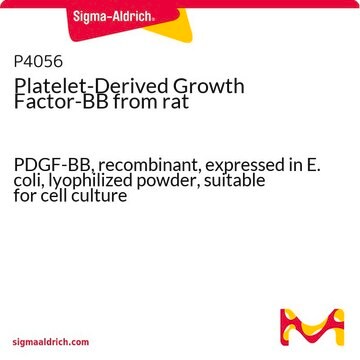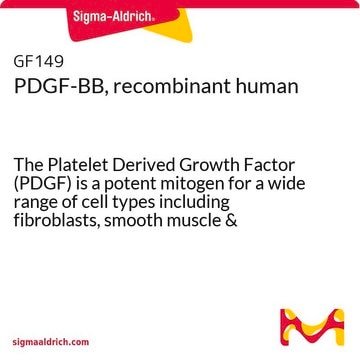07-1437
Anti-PDGF-BB Antibody
from rabbit, purified by affinity chromatography
Sinonimo/i:
Platelet-derived growth factor B chain precursor, Platelet-derived growth factor beta polypeptide, Platelet-derived growth factor, beta polypeptide (oncogene SIS), oncogene SIS, Platelet-derived growth factor, Platelet-derived growth factor beta, Platele
About This Item
Prodotti consigliati
Origine biologica
rabbit
Livello qualitativo
Forma dell’anticorpo
affinity purified immunoglobulin
Tipo di anticorpo
primary antibodies
Clone
polyclonal
Purificato mediante
affinity chromatography
Reattività contro le specie
human
tecniche
ELISA: suitable
neutralization: suitable
western blot: suitable
Isotipo
IgG
N° accesso NCBI
N° accesso UniProt
Condizioni di spedizione
dry ice
modifica post-traduzionali bersaglio
unmodified
Informazioni sul gene
human ... PDGFB(5155)
Descrizione generale
Specificità
Immunogeno
Applicazioni
0.2-0.4 ng/well when human PDGF-BB is used to coat the plate.
Neutralization: To yield ½ maximal inhibition (ND50) of the biological activity of hPDGF-BB (2.5
ng/mL), a concentration of 0.03-0.04 μg/mL of a previous lot of this antibody was required.
Immunohistochemistry(paraffin): Anti-IGF-1R, representative staining-pattern and morphology on ductal breast carcinoma. Tissue was pretreated with EDTA, pH 8.0 for Epitope retrieval. A previous lot of this antibody was diluted to 1:200 (RT incubation), using IHC-Select Detection with HRP-DAB.
Optimal working dilutions must be determined by the end user.
Signaling
Growth Factors & Receptors
Qualità
Western Blot Analysis:
1:500 dilution of this lot detected PDGF-BB on 10 μg of Huvec lysates.
Descrizione del bersaglio
Linkage
Stato fisico
Stoccaggio e stabilità
Handling Recommendations: Upon first thaw, and prior to removing the cap, centrifuge the vial and gently mix the solution. Aliquot into microcentrifuge tubes and store at -20°C. Avoid repeated freeze/thaw cycles, which may damage IgG and affect product performance.
Esclusione di responsabilità
Not finding the right product?
Try our Motore di ricerca dei prodotti.
Codice della classe di stoccaggio
13 - Non Combustible Solids
Classe di pericolosità dell'acqua (WGK)
WGK 1
Punto d’infiammabilità (°F)
Not applicable
Punto d’infiammabilità (°C)
Not applicable
Certificati d'analisi (COA)
Cerca il Certificati d'analisi (COA) digitando il numero di lotto/batch corrispondente. I numeri di lotto o di batch sono stampati sull'etichetta dei prodotti dopo la parola ‘Lotto’ o ‘Batch’.
Possiedi già questo prodotto?
I documenti relativi ai prodotti acquistati recentemente sono disponibili nell’Archivio dei documenti.
Il team dei nostri ricercatori vanta grande esperienza in tutte le aree della ricerca quali Life Science, scienza dei materiali, sintesi chimica, cromatografia, discipline analitiche, ecc..
Contatta l'Assistenza Tecnica.